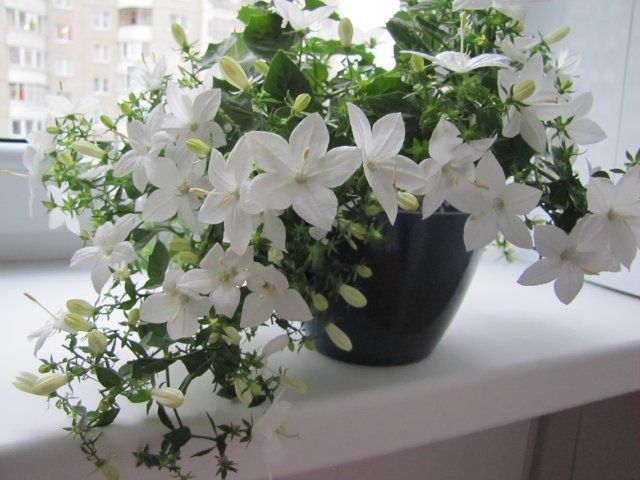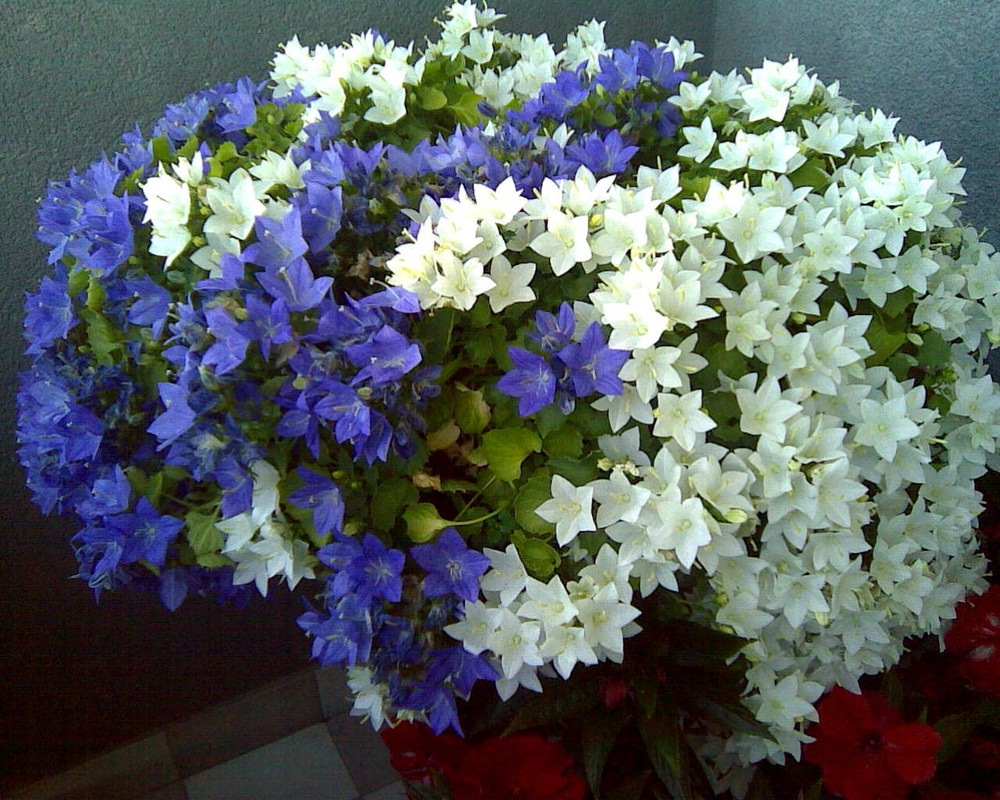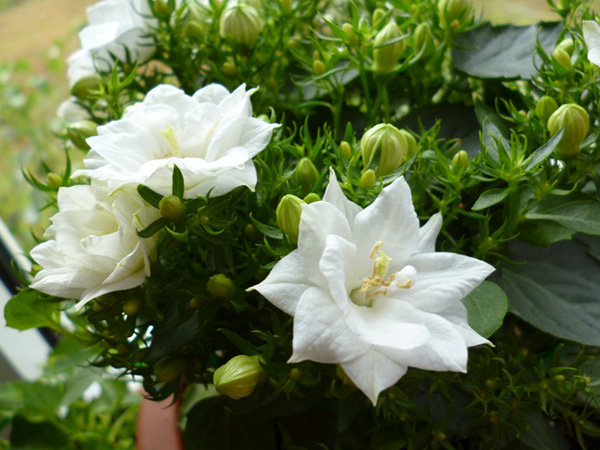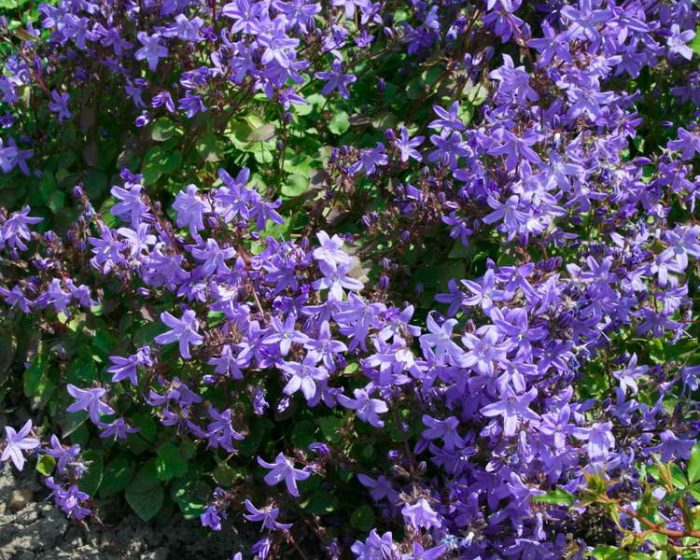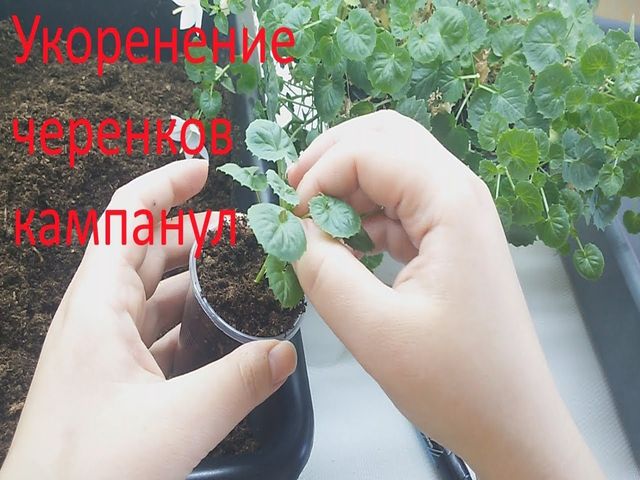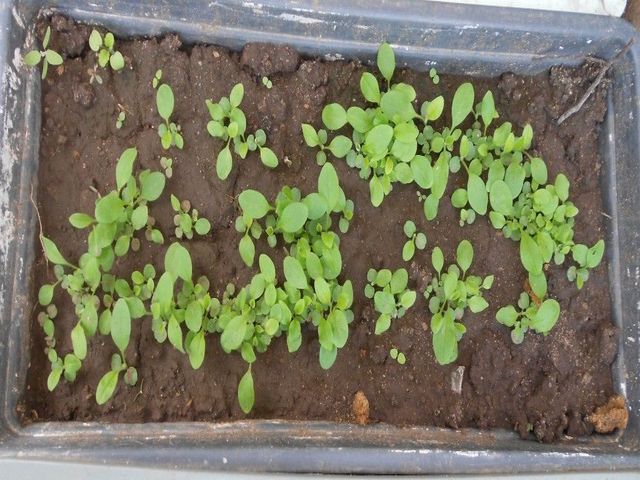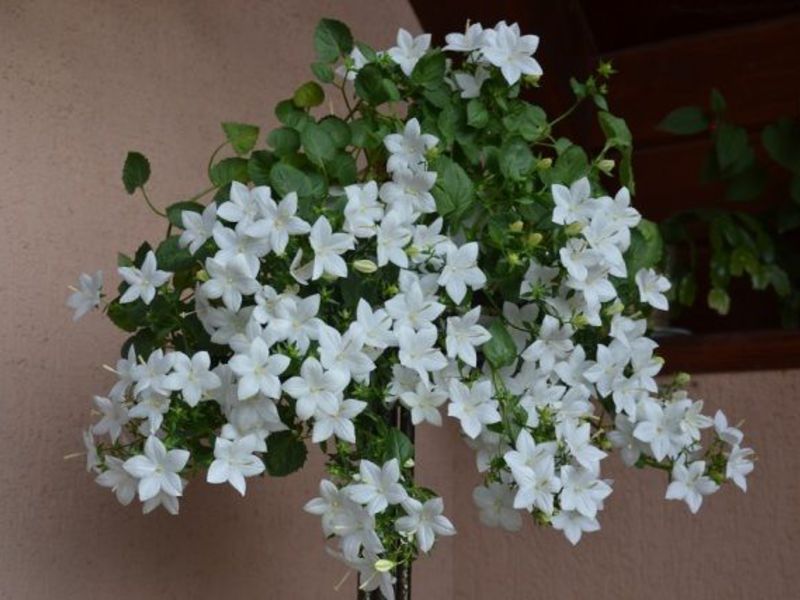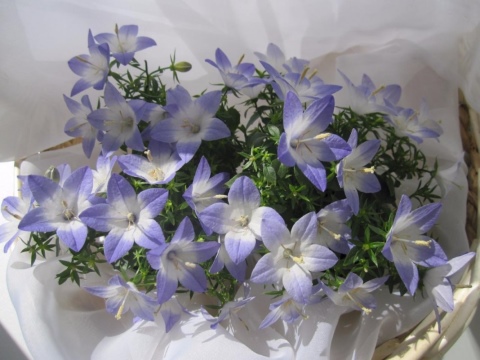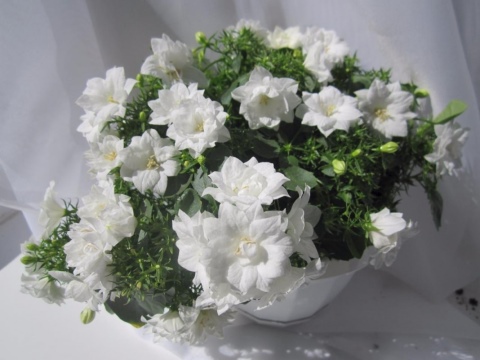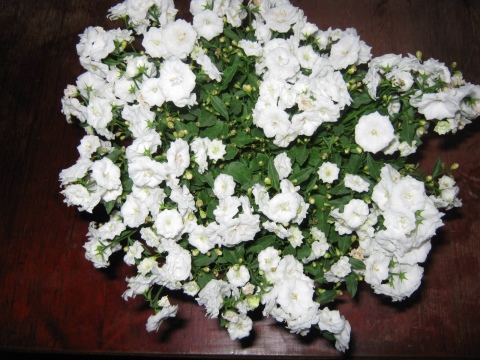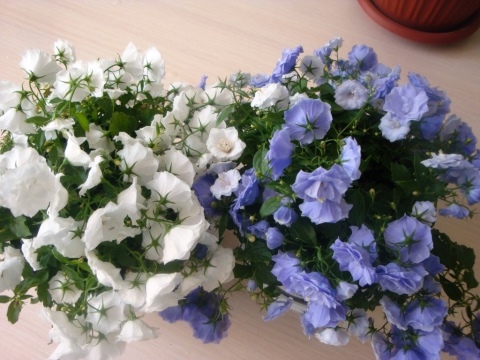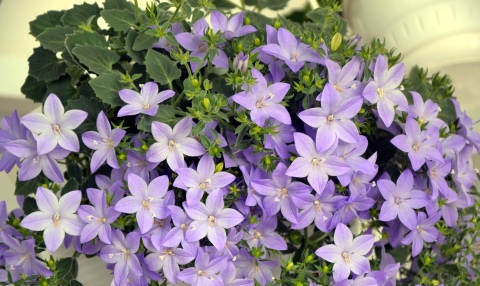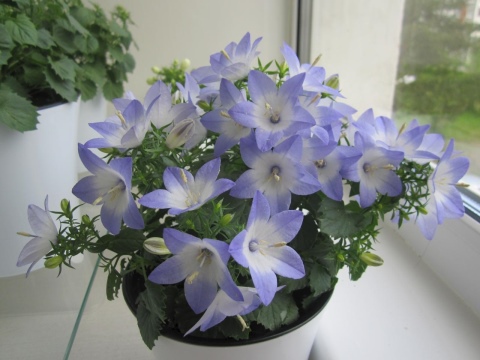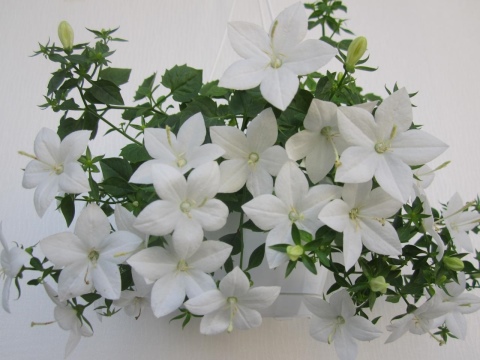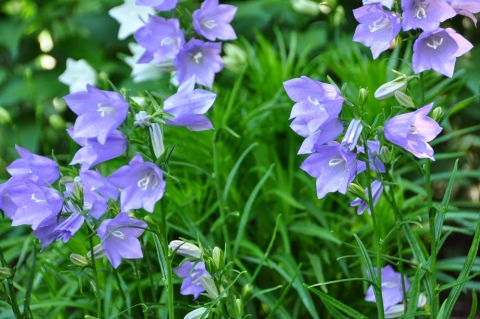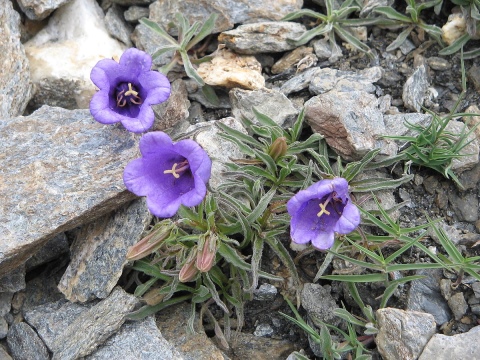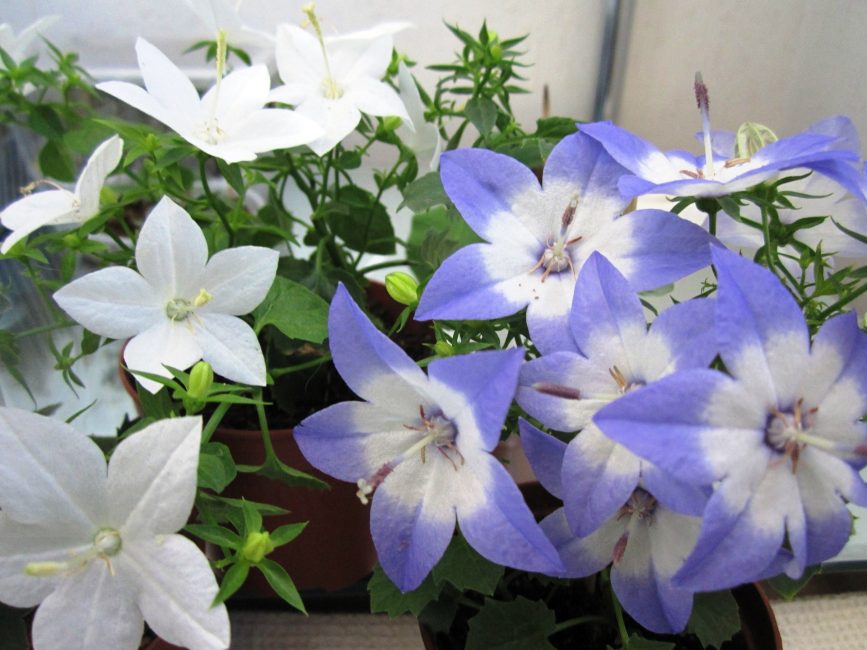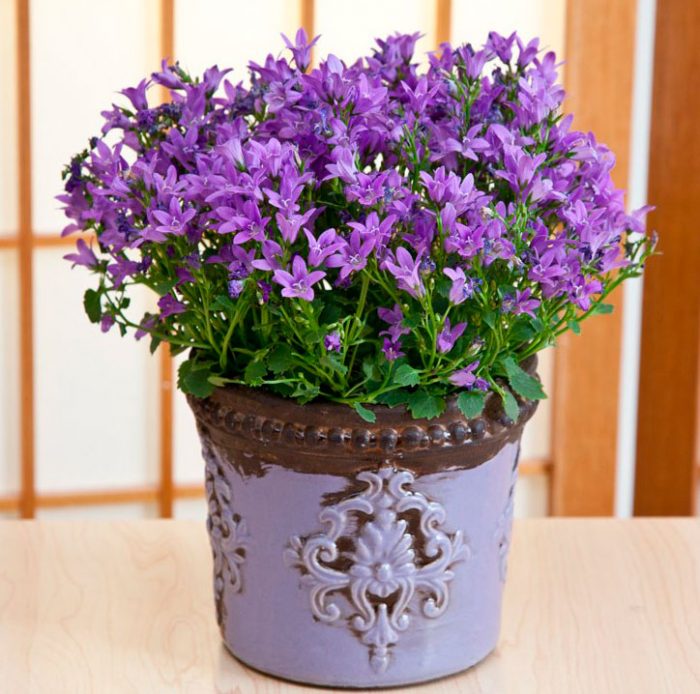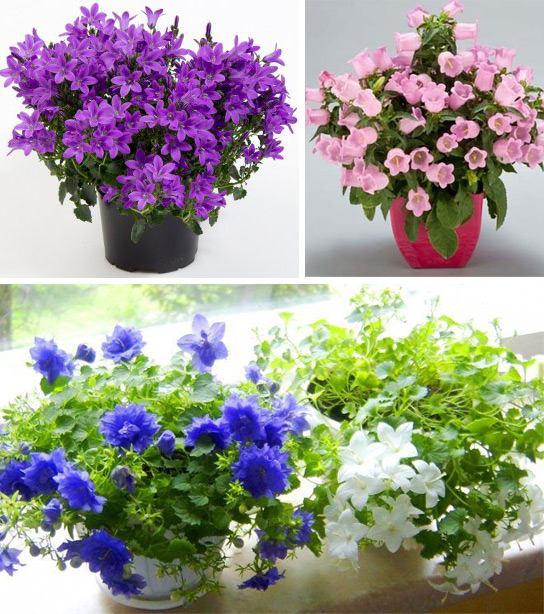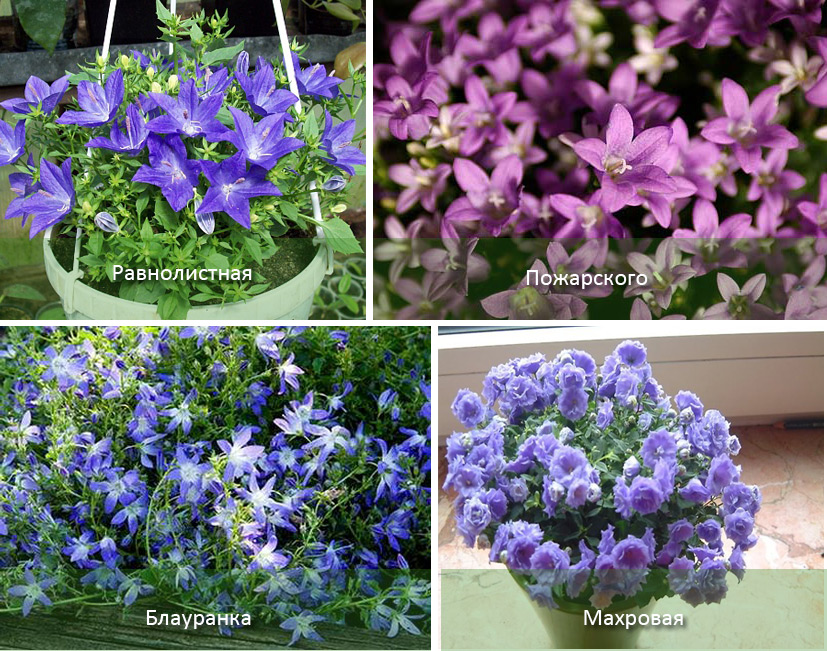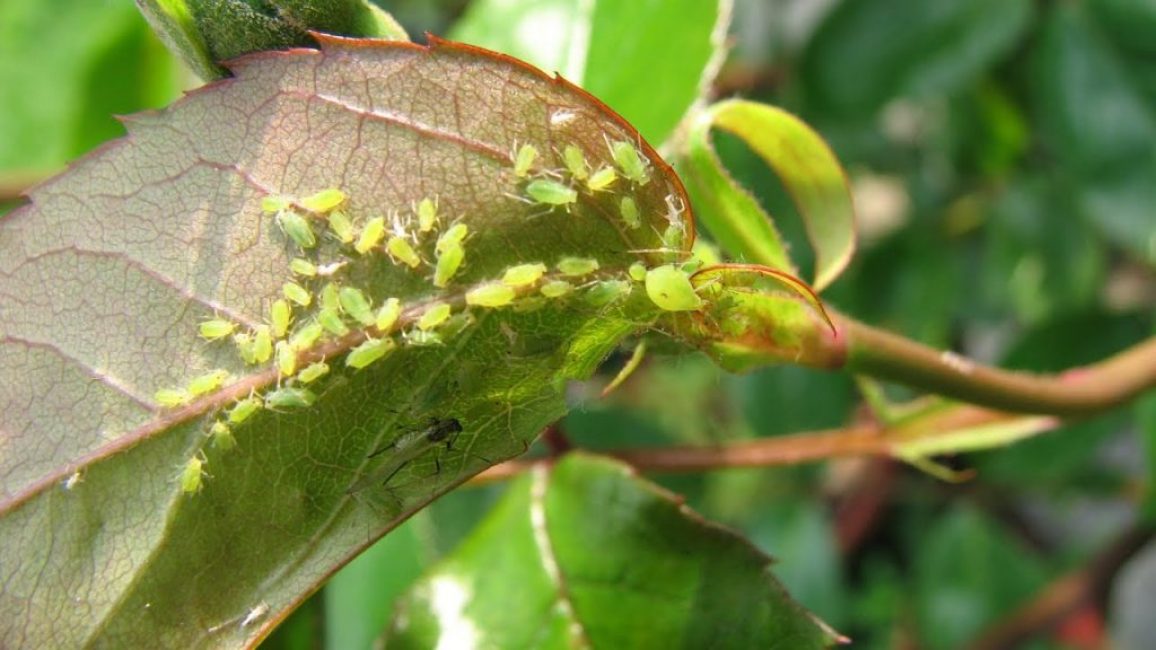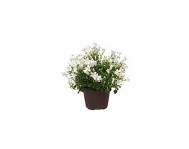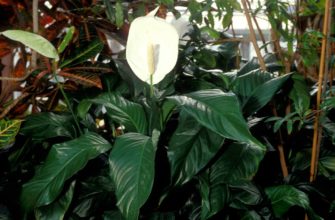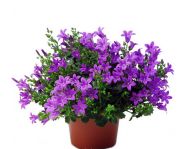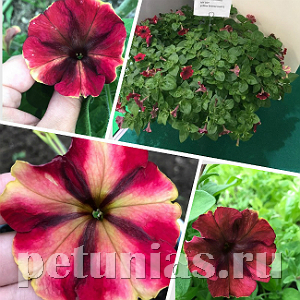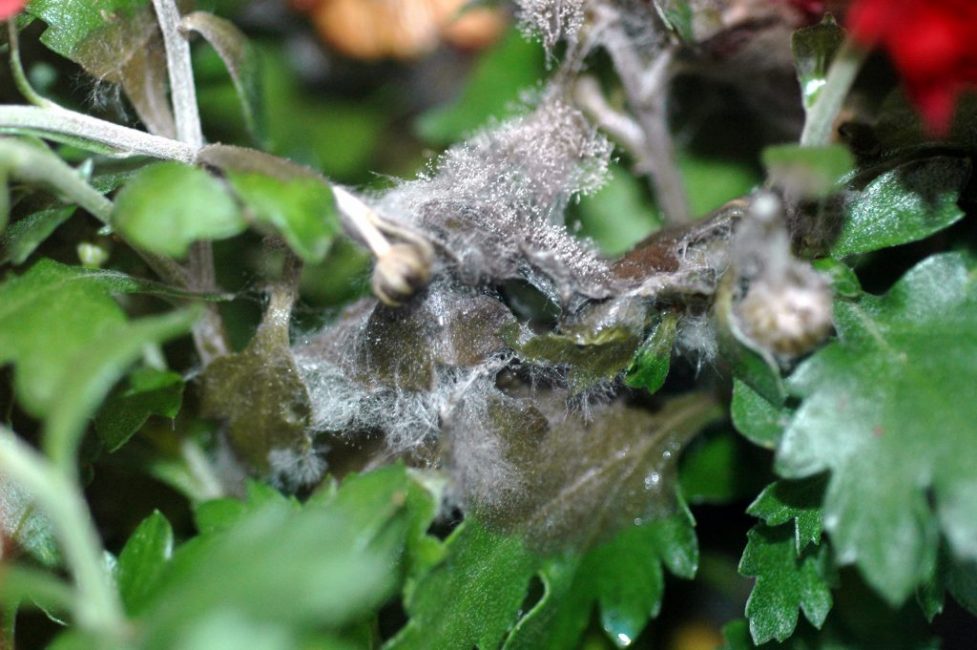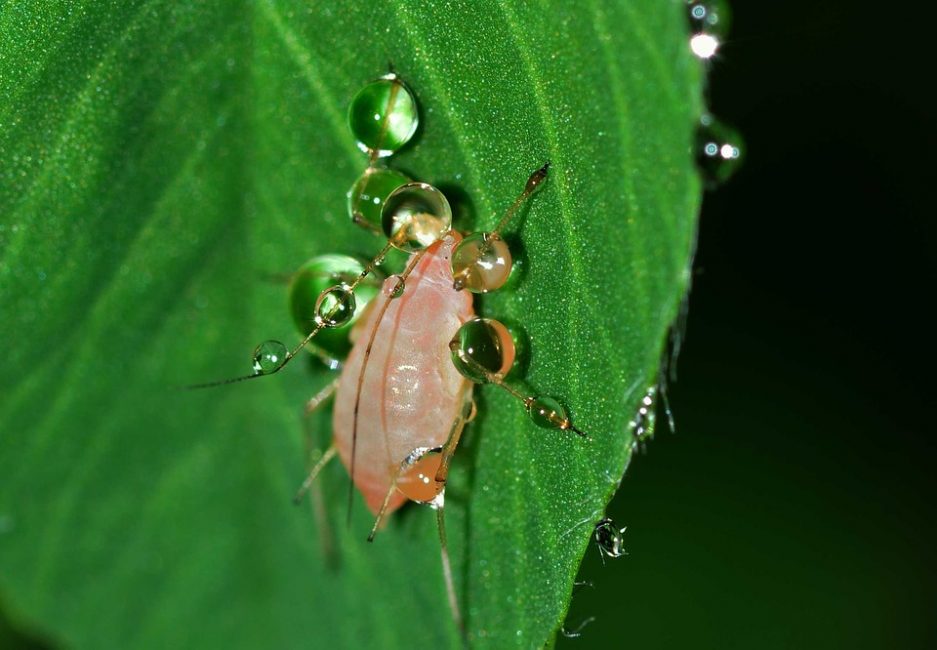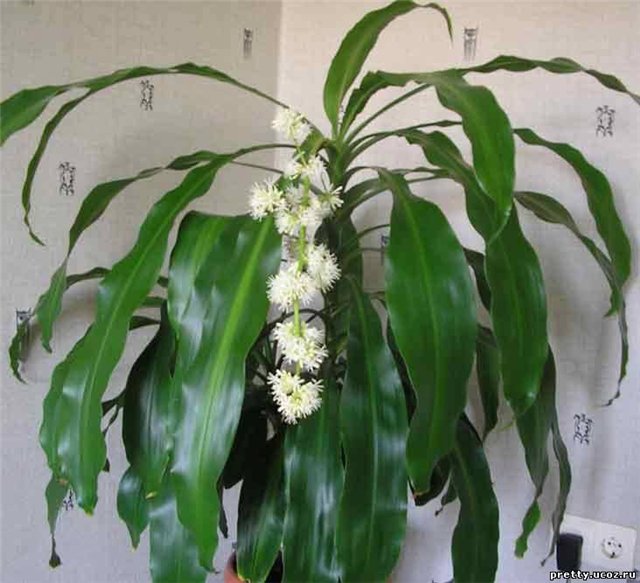Soil for campanula and transplanting
Unlike most indoor pets, Campanula does not require a special soil composition from you. You can successfully grow a flower both in universal soil and in ordinary soil, collected directly from the garden (it is better to sterilize it with steam or pour it with boiling water first). I try to give my beauties all the best, so I prepare the substrate myself:
- 3 handfuls of turf soil;
- 3 handfuls of humus (can be replaced with sheet soil);
- 2 handfuls of clean coarse sand.
The transplant should be done annually, at the very beginning of spring. Keep in mind that the plant ages quickly, and a bush that has not been worth it for more than 4 years into a new container will not please you with abundant flowering. It is better to root a young stalk, even in the first year it will be covered with flowers. The exception is Campanula Carpathica, it blooms only the next year.

What does campanula look like?
Campanula is a genus of herbaceous perennials belonging to the Campanulaceae family. At the moment, there are about three hundred of its representatives. Its name is translated from Latin as "bell" and because of the characteristic shape of the flowers in common parlance, campanula is often called bells. There is also a more poetic nickname - "shooting stars".
In nature, graceful bells often grow on seemingly bare rocks.
Campanula flowers are modest, but very graceful and elegant.
Campanula is distributed mainly in Europe and Asia, some species are found in North America. Its habitat is the Mediterranean coast, the Caucasus, the foothills of the Alps, Central Asia, Siberia. Campanula has no particular preferences regarding the climate - it feels good on meadows, forests, steppes, and rocky plateaus.
Campanula, as if by nature itself, is intended for cultivation by the ampel method. Only a stem up to 15 cm in height can stand directly. But the shoots of the plant are long (about 0.5 m), thin, so they sink under the weight of the flowers. The latter resemble miniature (up to 5 cm long and 2–4 cm in diameter) five-petal bells, painted in different shades of blue, blue, lilac or white.
A cascade of star flowers looks very impressive, but even in a pot, Campanula bushes look very elegant
But turning the campanula into a vine, trying to let it go up the support, is not worth it. The plant is absolutely not adapted to this, and, most likely, it will simply die.
Experienced flower growers note that when planting in one pot, the "bride" over time significantly squeezes the "groom", so it is advisable to install a partition in the flowerpot in advance
The flower is also appreciated by the adherents of the Feng Shui teachings. According to this philosophy, the plant creates a warm and cozy atmosphere in the house, improves the moral climate, contributes to the development of the owner's creative potential and literally "attracts" money and material wealth to him.
Campanula pleases the eye not only with flowers, but also with bright greens of salad color. Her leaves are heart-shaped, 3-7 cm long, on long stalks, are located on the stems alternately. In some species, the edge is carved with small teeth. The buds are collected in loose corymbose inflorescences. Flowering lasts almost six months - from mid-spring to late autumn.
Campanula greens also look very nice, but still this is not the main advantage of the plant.
The undoubted plus of campanula is the almost complete lack of attention from pets.The plant is not poisonous, they probably just don't like the taste. There is no need to move Campanula away, fearing that the bushes will be eaten by cats.
Campanula is a European plant, which means it has good frost resistance, therefore it is widely used in landscape design, including in Russia
Reproduction
If the plant has grown enough and does not fit in the volume of the container, it must be divided into several parts. A neat bush is removed from a pot with a lump of earth. Using a sharp knife, the rhizome is cut into pieces.
Do not forget to treat the cuts with crushed wood charcoal. Place the resulting parts in new containers of a smaller volume. It is not recommended to immerse the plants deep in the soil. Immediately after transplanting, provide the plant with abundant watering and shade.
Propagation by cuttings
Propagation by cuttings is a very simple and common way. The lower part of the shoots is taken on the cuttings. All actions begin in springtime. The plant wakes up and begins to grow. When young shoots reach up to 20 cm in growth, they are cut off and placed in a glass or jar of water. Can be dropped into the ground immediately. When planted in the ground, the cuttings are watered with a phytosporin solution and placed in a small greenhouse. For growing cuttings, the optimum temperature will be 12-13 ° C.
If the cuttings were planted in the summer, then in the fall they rest, and in January or February they will begin to bloom.
Rooting of cuttings is fast. After two weeks, small roots will already appear. As soon as the plant begins to actively increase the green mass, it must be transferred from the shaded light to the light and to a warmer place. When the seedling reaches 10 cm, it must be pinched. In this case, the plant will branch out to form a beautiful bush.
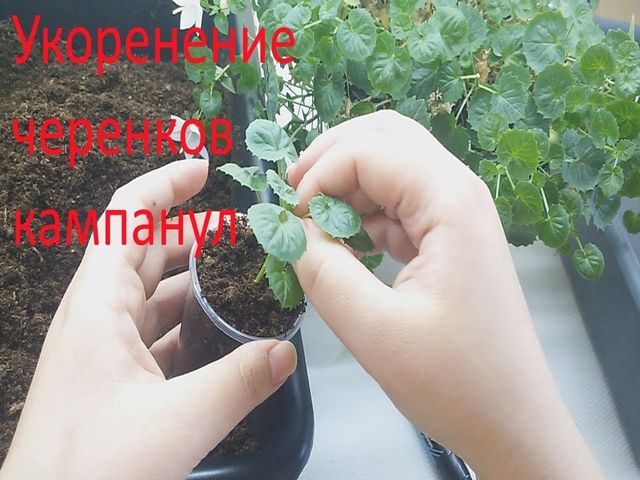
It happens that even despite the seemingly correct care, the plant suddenly begins to hurt.
Green shoots
This type of vegetative propagation should be resorted to in spring, when young green twigs grow near the campanula. They can be cut and rooted.
How to do it correctly:
- Separate the green scion with the "heel";
- Plant it in a mixture of loose peat and sand soil;
- Cover with plastic wrap;
- Provide greenhouse conditions;
- Keep the container with young shoots in a cool place at a temperature of plus 12-15 degrees;
- Remember to spray and ventilate the miniature greenhouse daily.

Mini greenhouse for rooting cuttings
Campanella takes root quickly enough, after two weeks small roots are formed. After the plants begin to actively build up their vegetative mass, transfer them to a lighter and warmer place.
Upon reaching a height of ten centimeters, the plant must be pinched so that it begins to branch out and bush.
Seed propagation
The seed plant is grown in a similar way to many others. In a prepared seedling container - a box filled with soil for seedlings, seeds are planted over the surface of the earth. The seeds are very small, so we look carefully to distribute them evenly. Next, sprinkle with earth. There is no need to water the seeds, just spray. In addition, the box with the seeds must be covered with foil to create a greenhouse effect.
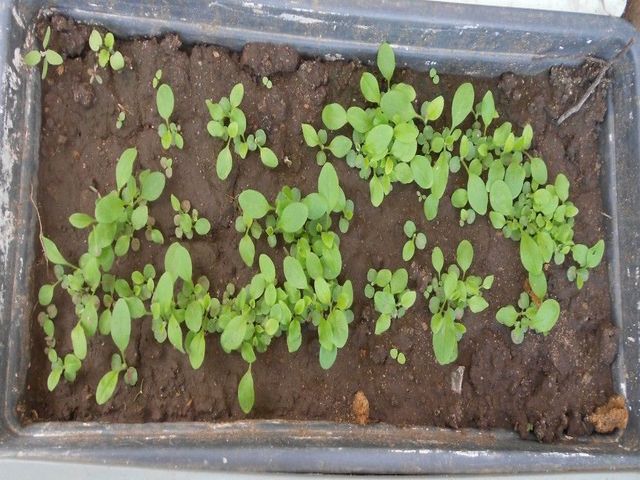
When the seedlings grow up and the first 3-4 leaves appear, it dives. Then, as it grows, it is transplanted to a permanent place.
Dividing the bush

A heavily overgrown bush can be divided into parts during transplantation. Treat the cut areas with charcoal powder. After that, the delenki are planted in separate containers. The planted cuttings are well watered and the first days are protected from direct sunlight.
Popular types and varieties of campanula
The birthplace of Campanula is the mountain slopes of the Mediterranean.Among the 300 varieties of plants growing in nature, only one species - Campanula isotopia - is cultivated for growing at home.
She also served as breeders for breeding new varieties that can live on the windowsill.
Campanula
Equivalent Campanula belongs to the Kolokolchikov family. Its range is the countries of Southern Europe. It is a perennial plant with slender stems up to 25 cm long, which can creep along the ground and occasionally hang down.

The leaves are arranged on elongated cuttings, colored in light and dark shades of green. They can be oval or heart-shaped in shape. Flowers with blue and white petals are collected in lush inflorescences.
As an indoor culture, Campanula indoor is represented by two popular hybrids: Alba with white flowers and Maya with blue flowers.
It was for these species that the popular name of campanula was given: the “bride and groom” indoor bell. Other types of plants are also suitable for growing at home.
It is interesting! The flower is considered a symbol of family happiness and fills the house with positive energy.
Pozharsky
The plant is represented by several species with similar characteristics. It has large leaves on cuttings up to 20 cm long, corollas in the shape of a star. All shades of blue, white and purple are found in the color of flower petals. The variety is adapted to open ground.
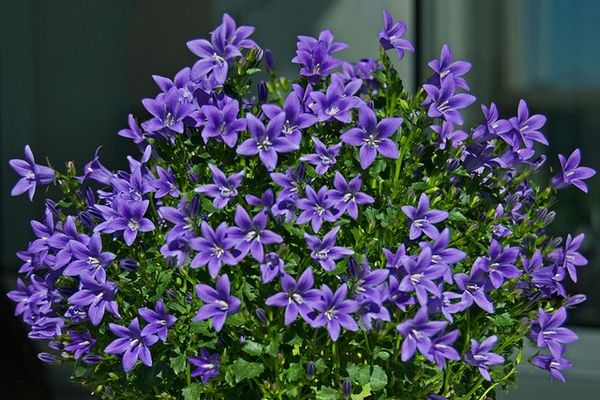
Terry
The beauty of this variety can be seen in the photo. Obtained by crossing Portenschlag and Karpatka, he surpassed his parents in all indicators of decorativeness. Terry flowers of this variety look like small roses, which looks especially delightful in blue. The leaves are attached to shortened cuttings extended upward. There are pink and white varieties. Experts believe that this variety is difficult to grow at home.
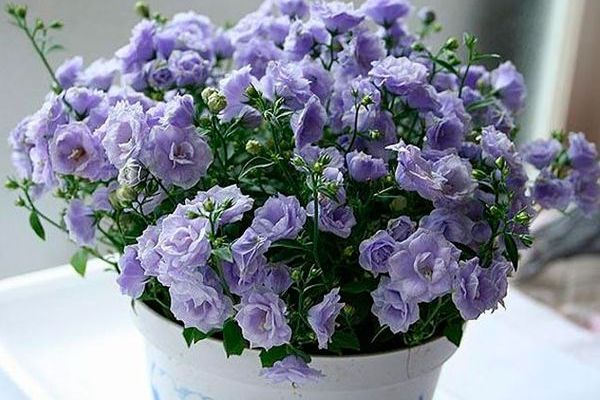
Mini
The Mini variety is a copy of the terry campanula, but with smaller flowers (up to 1.5 cm). The cuttings of the leaves are also shorter than those of the terry “bride”. The color of the petals is white, blue, blue and pink.
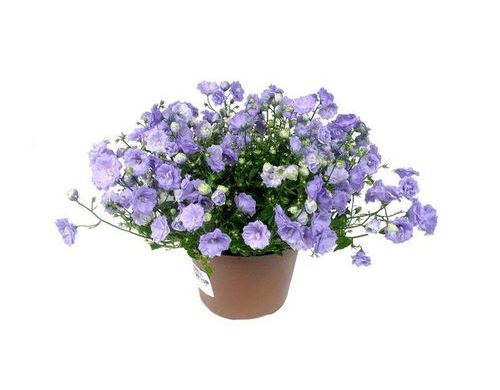
Portenschlag
It differs in short (up to 10 cm) stems, on top of which there is one bell flower. The flower size is 2.5–3 cm. Like other species, white and blue tones prevail in Portenschlag's range of colors.
Due to the low stems, an original cap of leaves and flowers is formed, hanging over the pot with a dome. Rounded or heart-shaped leaves have a serrated pattern at the edges. The plant is excellent for outdoor cultivation.
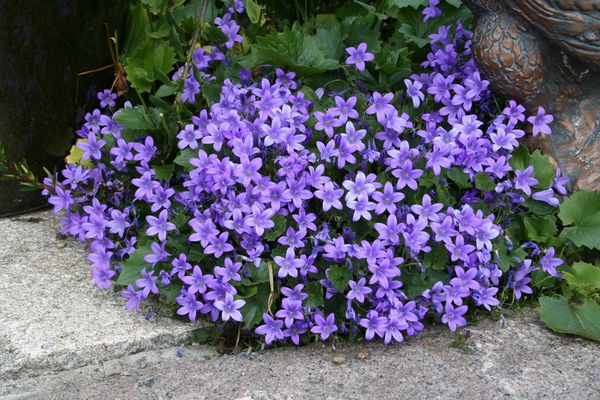
Carpathian
The variety belongs to those plants that have been successfully cultivated for both indoor and outdoor use. Lives in the Carpathians. Outwardly it looks like a miniature (up to 30 cm) bush. The leaves are collected in a root rosette.
The main difference between this species is large (up to 6 cm) flowers. It can bloom with blue, pink, white, purple flowers.
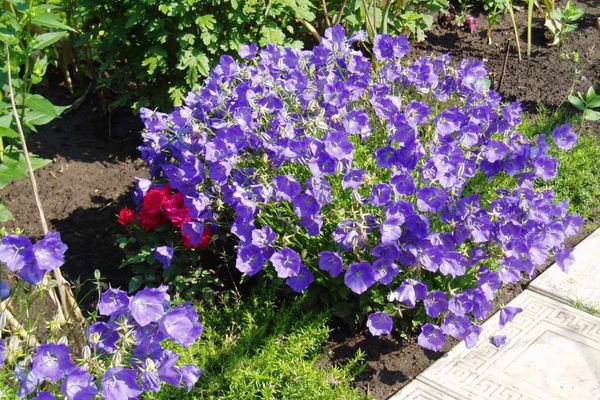
Napoli
Campanula Napoli was bred for growing in garden plots, the variety is also suitable for indoor keeping. It looks like a small bush with erect stems. The plant has heart-shaped, medium-sized leaves, the flowers are blue with a purple tint.
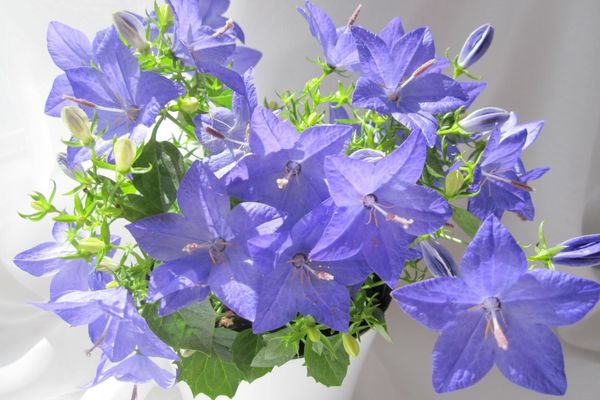
Purchasing a plant

Before proceeding with the implementation of our recommendations, you must purchase the plant itself. You can buy it in stores, having studied the flower departments. I must say that he is not a very frequent visitor to such places. But if you are lucky, then you will become the proud owner (or possessor) of this green pet.
The second purchase option is to buy from grandmothers. Ask around, maybe someone will agree to sell you a young plant.
Root check
If outwardly the root system looks pretty good, do not rush to transplant the beauty. First, she needs to be acclimatized in your apartment or house. This is a stressful situation, and if you add a transplant to it with the release of the roots from the soil, it will not be difficult to ruin the flower.
Dilute Fitosporin in water. The concentrate should resemble strong black tea in color. Prepare an irrigation solution from this concentrate: 15 drops per liter of irrigation water. Spill “Fitosporin” on the plant. This should be done as soon as you arrived home and looked at the roots. "Fitosporin" will destroy fungi and spores that promote the spread of root and other rot.
Pest control
Now let's examine the green mass of the plant. Often unexpected guests “come” to us from the store - all kinds of pests affecting leaves and flowers. If light dots are noticeable or something else bothers you in the general appearance of the plant, treatment is needed. You can use Fitoverm or Intavir. Dilute the preparation according to the instructions and process the aerial part of the plant. By the way, you can water the earth, if the soil allows.
Trimming shrunken parts
We can say that your indoor flower “bride” has been saved. How to look after further? Remove anything that has bloomed on the plant. Use sharp scissors to carefully cut off damaged leaves and broken stems. Now your “bride” is almost ready for the next step in post-purchase processing.
Campanula transplant
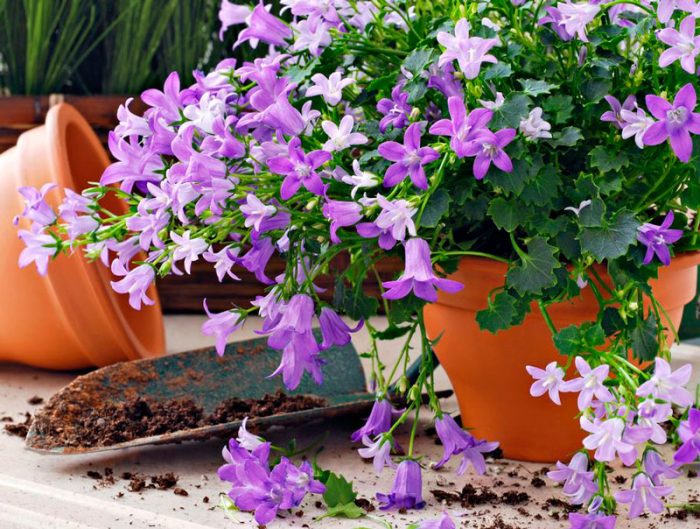
The newly purchased campanula is not disturbed for several days, during which time it must adapt to new conditions. After that, it must be transplanted. For this, a wide pot is used, at the bottom of which a good drainage layer is made. A suitable soil mixture must be loose, its composition: peat, humus, coarse sand and leafy soil (1: 1: 1: 1).
Further, the bush is transplanted in the spring at the very beginning of active growth. But experienced florists advise not to transplant an old bush, but to grow a new flower from cuttings in spring.
Campanula care at home
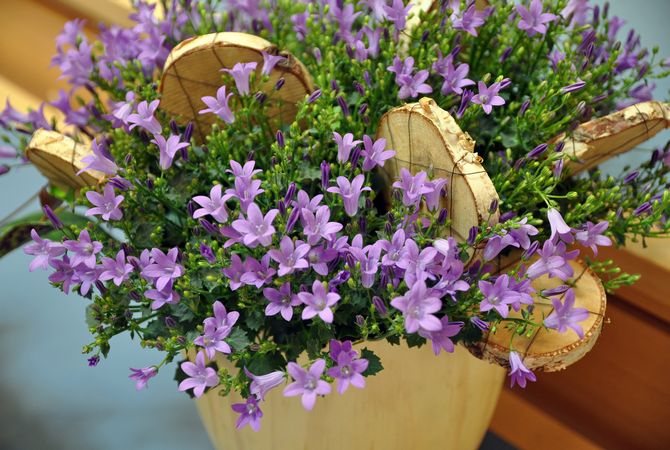
Campanula is a very vulnerable, but not whimsical plant, which can be easily grown not only by an experienced florist, but also by an amateur.
Location and lighting
When choosing a place in an apartment for the "flower of family happiness", one should take into account that this plant is a photophilous one. At the same time, direct sunlight is categorically contraindicated for her. In the hottest hours of the day, the campanula must be shaded, or rearranged to a less illuminated place.
The eastern and western windows are perfect for placing bells, but on the southern and northern sides this plant develops rather poorly and feels the same. If for some reason it is not necessary to choose, and the campanula can only stand on the north or south side of the apartment, it is necessary to provide the flower with additional artificial lighting for several hours a day.
In the warm season, Campanula takes root well in the open air. If you take care of protecting the plant from the scorching sun, pots with campanula can be placed in the garden or on the balcony - they will be a wonderful decoration both in the house and on the street. You can take the plant out into the open air after the onset of spring. As for the return of the flower to the apartment, the most optimal time is the end of September.
Temperature

Bells tolerate temperature fluctuations well, however, the recommended conditions for their existence are as follows: in winter - 15 degrees, in summer - 22-25 degrees.
Important: if the plant is on a windowsill, under which there are batteries, it is better to remove it from there during the heating season.
Air humidity
The moisture level when growing campanula is not of great importance. "Flower of family happiness" feels comfortable even in a room with dry air. But this does not mean that you can forget about the periodic humidification of the air in the room forever, since this factor affects the development of the plant along with other conditions of its existence.
Watering
A campanula flower can go without watering for several weeks.The convenience of caring for this plant is especially noted by very busy people and travel lovers, because their short absence from the house will not cause any harm to the bells. An exception to this rule can be called the summer season, when the campanula requires regular and correct watering. In the hot season, it is strictly forbidden to allow the soil in the flowerpot to dry out, otherwise the flower may get sick and even die. To water the bells, you should use pre-settled warm water.
Important: Hard, untreated tap water can kill the plant. You can solve this problem with a conventional water filter.
The soil for the "flower of family happiness"
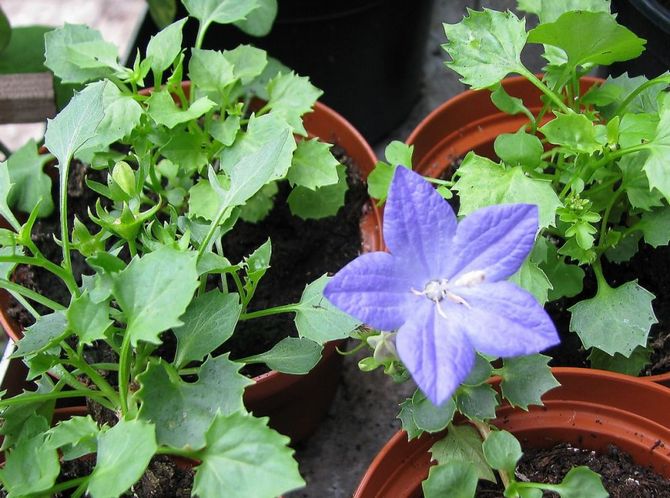
The soil for the bells should be easily loosened so that the roots of the plant are enriched with sufficient oxygen. The most ideal soil for growing campanula is a mixture of peat and leafy soil.
During periods of active growth and flowering of the bush, it will not be superfluous to take care of additional plant feeding. Bells are fed several times a month, depending on the recommendations in the instructions. To bait campanula, you can use complex fertilizers for flowering indoor plants, which can be purchased at the floriculture department.
In rest mode, the campanula does not need fertilization, and failure to follow the correct bait regimen can cause serious harm to the plant.
Bell transplant
Do not forget that Campanula is not a perennial plant, and it does not need a traditional transplant. At the same time, many growers are faced with a problem when the plant grows too quickly, and it becomes cramped in a small pot. It is in this case that it is advisable to change the conditions of its habitation. Transplanting campanula is possible only in the autumn and spring periods of the years.
How to transplant bells correctly? To do this, you need to put a layer of drainage and fresh soil in a new pot, and then place a plant removed from a cramped flowerpot with a lump of earth on the roots in it. Next, you should align the bush in the center of the flowerpot, gently tamp the soil with your fingers and water the plant.
Outdoor care rules
Caring for terry campanula outdoors is not much different from caring for simple varieties of this genus. However, it is worth paying more attention to it. Any violation will lead to the termination of flowering. Describing the basic growing conditions will help reduce the risk of flower loss.
Location and lighting
Terry beauty loves rare sunlight. Therefore, it grows better in an open area with little shading.
Soil and fertilizers
To grow terry campanula, you need to take loose soil. It is best to use the following composition for her:
- 6 pieces of turf;
- 3 pieces of leafy land;
- 1 part peat;
- 1 part sand.
Drainage is placed in the flowerbed as the first layer. This is necessary to drain excess water and prevent root rot. The prepared soil is the second layer. If it is not possible to make soil from the above composition, then sand and humus can be added to the soil of the site. This will lighten the ground and the roots of the plant will be able to breathe.
If the land of the site passes water well and does not swamp, then when planting a bell, you can do without drainage.
Watering and humidity
When growing campanula, both excess and lack of moisture should be avoided. In spring and autumn, it is enough to water the plant 2 times a week; in hot weather, you will have to do this every day.
To determine the need for watering, you need to inspect the root hole. If the topsoil is dry, then watering is required.
Important! To retain moisture in the soil, the root zone is mulched with pine needles or chopped straw. It is better to water the plant in the evening.
At the same time, make sure that water does not fall on the buds. Watering in the evening will help prevent sunburn on the leaves. The flower is not picky about moisture
It is better to water the plant in the evening. At the same time, make sure that water does not fall on the buds. Watering in the evening will help prevent sunburn on the leaves. The flower is not picky about moisture.
What kind of plant
A gentle houseplant, which many flower growers love so much, is called a bride in the common people. This flower also has a completely scientific name. In the biological reference book, it is called Campanula, which means "bell" in translation.

Campanula white in a pot on a windowsill
The houseplant campanula, or bride, is a small herbaceous perennial, about 15 centimeters high. It has creeping creeping stems with long petioles with small (up to 5 cm) heart-shaped leaves. The surface of the leaves is light green with jagged edges.
Paniculate inflorescences, flowers are pale blue, lilac or white. The shape of the flowers is a five-petalled bell; its shape is very much like a star. The size of the flowers is small - about 3 centimeters in diameter. In the common people, campanula with white flowers is called a bride, its variety with blue flowers is called a groom. The period of abundant flowering lasts from the first days of June to the end of October.
Scientific name for "groom" and "bride"

In fact, the flower is a bell, so beloved by everyone since childhood. And this is how the flower “bride” is called scientifically - this is campanula, like, in fact, all the famous bells. The plant is perennial and herbaceous.
The “bride” or “groom” bloom at home practically without interruption. The “bride” will delight especially magnificently if you provide her with a little more comfort for life. And it’s worth it, because the “groom” and “bride” flowers are considered a family talisman.
Description
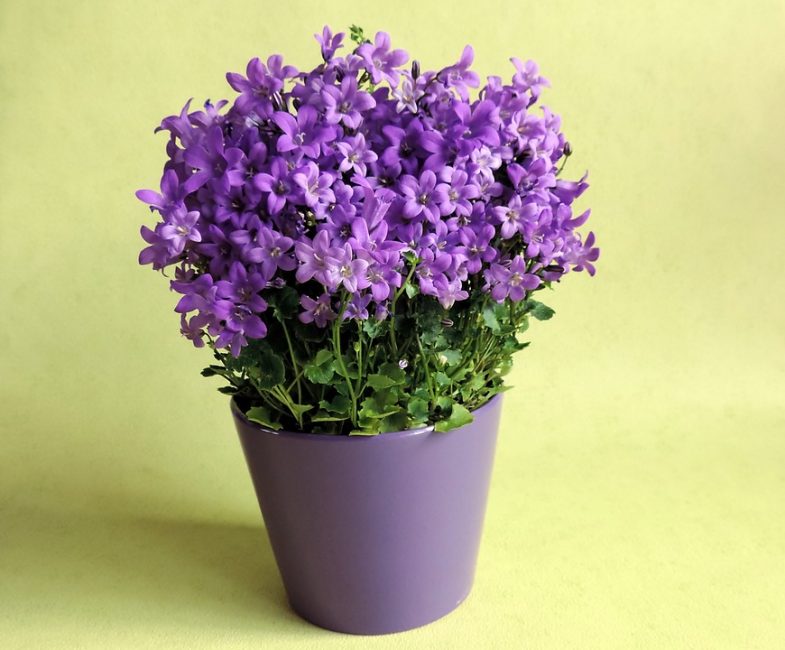
Hybrid with lilac color of flowers
Campanula is a well-known houseplant that belongs to the bellflower family. In the wild, it can be found in many countries of southern Europe.
A significant number of species of this plant have been domesticated, and are now actively used as a houseplant.
- Campanula is both annual and perennial.
- Plants are varied in shape, flower color, size, there are hybrid double forms.
- Campanula is cultivated as indoor crops. This plant is perennial, with thin shoots, sometimes creeping, in rare cases - hanging up to 25 cm long.
- The arrangement of the leaves is alternate; the leaf blades are attached to the stems with the help of elongated petioles.
- Leaf shape is cordate or oval with small denticles. The leaves are light green to dark green in color.
- Flowers are collected in inflorescences of several pieces, after flowering a small fruit appears in the form of a box.
- Among lovers of indoor flowers, the most common hybrid is "Alba" (with white flowers) and "Maya" (with blue or purple flowers). They are popularly called "the bride and groom".
 Hybrid "Alba"
Hybrid "Alba"
All representatives of the bellflower family are not very demanding, they need the most elementary - watering, moderate lighting, periodic feeding.
Soil and transplant
An important part of caring for a flower at home is the choice of soil mixture. Ideal - a substrate of peat and deciduous humus
The contents of the pot should be loose. So the roots will not suffer from a lack of vital oxygen.

Top dressing is done during active growth. The frequency of application is a couple of times a month. Liquid formulations are suitable for flowering indoor crops. With the onset of hibernation, feeding is stopped.
The transplant is carried out when the grown bush is cramped in the flowerpot. Drainage material (expanded clay, pebbles) must be laid at the bottom of the new container, then soil is poured and a flower with an earthen lump is transferred. All are tamped and watered.

Pests and diseases
- What to do if Campanula dries up? If the leaves of your flower dry, turn yellow or have lost their brightness, move it to another place. The plant is most likely receiving too much light.
- If the stems become thinner and grow rapidly in length - on the contrary - there is not enough light. Turn on the phytolamp for 5-6 hours a day.
- Sluggish, soft to the touch foliage speaks of overflow.
- Gray rot is determined by the appearance of gray spots and black dots on the leaves of the campanula. Cut off the damaged parts, treat the cuts with crushed activated carbon, and soak the root system in a solution of potassium permanganate (pale pink) or fungicide for half an hour. The same procedure is for root rot.
Spider mites and scale insects often attack campanula, so keep in stock insecticides: Aktara, Metaphos, Fitoverm, Permethrin. But first: wash the plant in the shower (cover the pot with plastic to prevent the soil from acidifying). After - put the flower in a plastic bag, sprinkle with the preparation inside and, having tied it, leave it for half an hour. Then the plant is washed again. The procedure should be repeated after a week.
Campanula care at home
Features of watering and feeding
In the summer, campanule requires regular watering. The substrate in the flowerpot should not be allowed to dry out, so you need to moisten the flower daily. In this case, it is best to carry out the procedure in the morning or evening hours, since watering on hot soil can lead to burns of delicate roots.
In winter, during a period of relative dormancy, the humidification of the bell should be reduced to once a week, since the roots of the campanula can rot with excessive dampness and coolness. In addition, the shoots will grow thin and too fragile.
The bell blooms almost without interruption for several months in a row, which greatly depletes the plant. To maintain its strength, it is necessary to regularly apply fertilizers to the soil. Top dressing from early spring to late summer should be done every two weeks. Preparations for violets, for example, Kemira-lux or Fertika, are suitable. They need to be diluted according to the instructions and the campanula should be poured with a nutrient solution over damp ground.
How to make campanula bloom
The bell begins to bloom in late May and early June. The period lasts for several months. In summer, the flowers completely cover the shoots, and in late August and early September, flowering gradually fades away. To stimulate the formation of new buds, you need to systematically pinch off old flowers.
Sometimes it happens that the campanula does not want to bloom. To prevent this from happening, it is necessary to arrange a relative rest period for the plant in winter. Place it on a cool window, but brightly lit. Stop feeding and reduce watering. After such stress, the flower will bloom very luxuriantly.
Pruning and shaping the bush
The bride and groom are ampelous plants. When planting, you need to cut off the shoots, leaving 2-3 cm from the root.
A very beautiful composition is obtained by planting plants with blue flowers (groom) and white bells (bride) in one pot. Experienced flower growers say that over time, the bride begins to grow more actively and oppresses the groom. To prevent this from happening, when planting plants in one flowerpot, install a partition in the middle of the planter and put the bride and groom in different parts of the pot.
The consequences of improper care and how to solve problems - table
| Problem | Possible reason | How to fix the situation |
| Campanula leaves fade or turn yellow | too hot temperature | Move to another place or shade with a curtain. |
| The stems become thin and elongated | lack of light | Move to a window with a brighter light or supplement the campanula with a fluorescent lamp. |
| Leaf blades wither | excessive watering | Transplant the plant into fresh soil and adjust the watering schedule. Moisturize only after the top layer of the pot is dry. |

